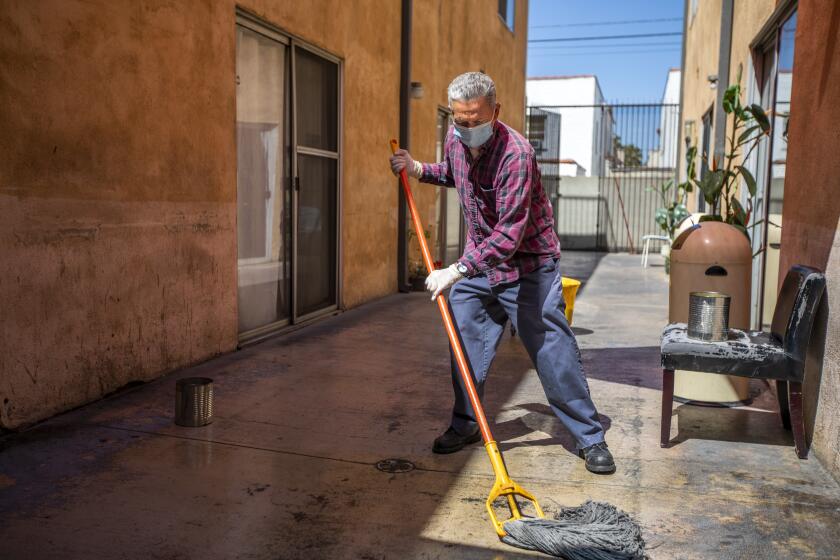Board and care homes could make a dent in homelessness but remain underfunded, study finds

- Share via
Board and care homes, which could make a significant dent in Los Angeles County’s homelessness crisis, remain underutilized and underfunded, a new study has found.
The homes were first developed in California more than 50 years ago as the state closed its asylums and moved mental health patients into communities. They are privately operated and range from small mom-and-pop operations with fewer than 20 residents to large facilities with more than 100 people.
Today, relatively few board and care homes serve people with mental illnesses. The rest house people 60 and older or those with developmental disabilities. More than 100 board and cares have closed in L.A. County in recent years, in part because of low government reimbursement rates.
The study, released this week, is the first comprehensive analysis of how many board and cares operate in L.A. County, the challenges the homes face and possible ways to save the shrinking industry. It was authored by the Future Organization, a consultant group hired by the housing nonprofit Brilliant Corners with funding from the California Community Foundation and Cedars-Sinai.
Of the 3,065 board and care homes operating in L.A. County, the study estimates there are 750 that serve or are willing to serve people on public benefits, those living with mental illness or those who have been homeless.
The rest were generally not interested in housing these people, either because they serve adults with developmental disabilities under a different funding system, or because they take only older residents who are on private insurance or can self-pay.
With advocacy from local leaders, some homes might be persuaded to change their clientele — especially if they were paid more, the researchers noted.
More than half of operators surveyed told researchers that their “main priority for government is to increase resident care funding,” with many expressing “very high levels of dissatisfaction with the current reimbursement rates.”
Hundreds of board and care homes for people with serious mental illness have closed in recent years across California, raising concerns that residents could become homeless.
Operators are paid $44 a day for each resident with serious mental illness, versus about $191 to $391 a day per person with developmental disabilities — a discrepancy that advocates have said must be fixed if the lower-funded board and care homes are to survive.
“The cost of the kennel for your pet ranges $50 to $160 a day,” said Bennie Tinson, executive director of board and care advocacy group LARCA. “We’re talking about human beings only receiving $44 a day.”
Janice Hahn, chair of the L.A. County Board of Supervisors, who has authored several motions involving board and cares, said in a statement:
“Board and care facilities are vital resources for many of our vulnerable residents including individuals who are experiencing homelessness, and yet many of them are at risk of closing. The reimbursements our board and cares get from the state and social security aren’t enough to cover their costs.”
It is far cheaper to house a formerly homeless person in a board and care — about $20,700 a year — than the more than $34,000 that L.A. County pays to serve each person without permanent shelter, the study found.
Board and care homes are generally seen as the best setting for people who need support with daily living. They are served three meals and two snacks a day and are handed their medications and given rides to appointments. Some homes throw birthday parties and organize field trips.
Residents of board and care homes reported being fairly happy, according to the study. About 88% indicated that they felt “like they were part of a community,” with about 78% indicating that their facility “feels like a home.”
About 65% of residents interviewed said they felt safer than in previous housing, with 52% saying they felt “less lonely.”
About 89% said they didn’t have any unmet needs at their board and care. The remainder said their main complaint was the quality and variety of food.
When a board and care closes, precious affordable housing vanishes — sometimes turning residents onto the streets. Critics say leaders in Sacramento have not done enough to support the homes.
Nearly half said they would like to graduate to another type of housing, with many saying they would like a chance to live on their own.
Some people with mental health needs who are in permanent supportive housing and live in their own apartments might do better in a board and care home, said Aimery Thomas, the report’s author, who is a managing director at the Future Organization.
But board and care homes aren’t linked to the system that social workers use to find available beds, Thomas said.
Nearly half of board and care residents interviewed said they had been homeless at some point in their lives, with about 11% reporting that they had arrived directly from being homeless.
But almost 60% of board and care operators reported having “no contact at all” with homelessness services providers, underscoring the disconnect.
Mayor Karen Bass has gotten a big ask from the U.S. Dept. of Housing and Urban Development, which has agreed to allow LA to put homeless people into housing before they compile all the documentation necessary to prove their eligibility.
Board and cares do not qualify for federal Housing and Urban Development money. And they aren’t in line with the “Housing First” philosophy that prevails locally and essentially demands that people receive “housing” — a definition that isn’t met by board and care homes — before getting comprehensive social services.
Board and cares are “a significant blind spot” in the discussion on addressing homelessness, occupying little space in the thinking of most elected officials in city, county and state government, with the exception of the L.A. County Board of Supervisors, the report said.
Many homeless service providers and officials surveyed by the study’s researchers said they viewed board and cares as “human warehouses” without sufficient mental health and social services to help residents one day leave and live independently.
Board and care homes need to be integrated into the data systems used by homeless service providers and viewed “as a genuine housing resource,” the study said.
The study calls on elected officials to fund board and cares at rates similar to permanent supportive housing.
More to Read
Sign up for Essential California
The most important California stories and recommendations in your inbox every morning.
You may occasionally receive promotional content from the Los Angeles Times.

















